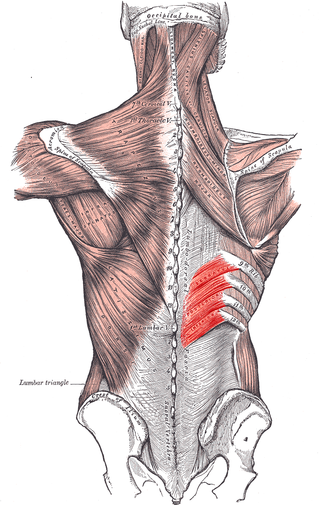Top Qs
Timeline
Chat
Perspective
Serratus posterior inferior muscle
Muscle of the mid-low back From Wikipedia, the free encyclopedia
Remove ads
The serratus posterior inferior muscle, also known as the posterior serratus muscle,[citation needed] is a muscle of the human body.
Remove ads
Structure
The muscle is situated at the junction of the thoracic and lumbar regions.[1] It has an irregularly quadrilateral form, broader than the serratus posterior superior muscle, and separated from it by a wide interval.
It arises by a thin aponeurosis from the spinous processes of the lower two thoracic and upper two or three lumbar vertebrae.[1]
Passing obliquely upward and lateralward, it becomes fleshy, and divides into four flat digitations.[1] These are inserted into the inferior borders of the lower four ribs, a little beyond their angles.[1]
The thin aponeurosis of origin is intimately blended with the thoracolumbar fascia, and aponeurosis of the latissimus dorsi muscle.[citation needed]
Remove ads
Function
The serratus posterior inferior draws the lower ribs backward and downward to assist in rotation and extension of the trunk.[1] This movement of the ribs may also contribute to inhalation and forced expiration of air from the lungs.[2]
Additional images
- Position of the serratus posterior inferior (shown in red). Animation.
- Close up. The muscle arises from the vertebrae T11 through L2 and inserted into lower border of the 9th through 12th ribs.
- Lumbar triangle
See also
References
External links
Wikiwand - on
Seamless Wikipedia browsing. On steroids.
Remove ads





